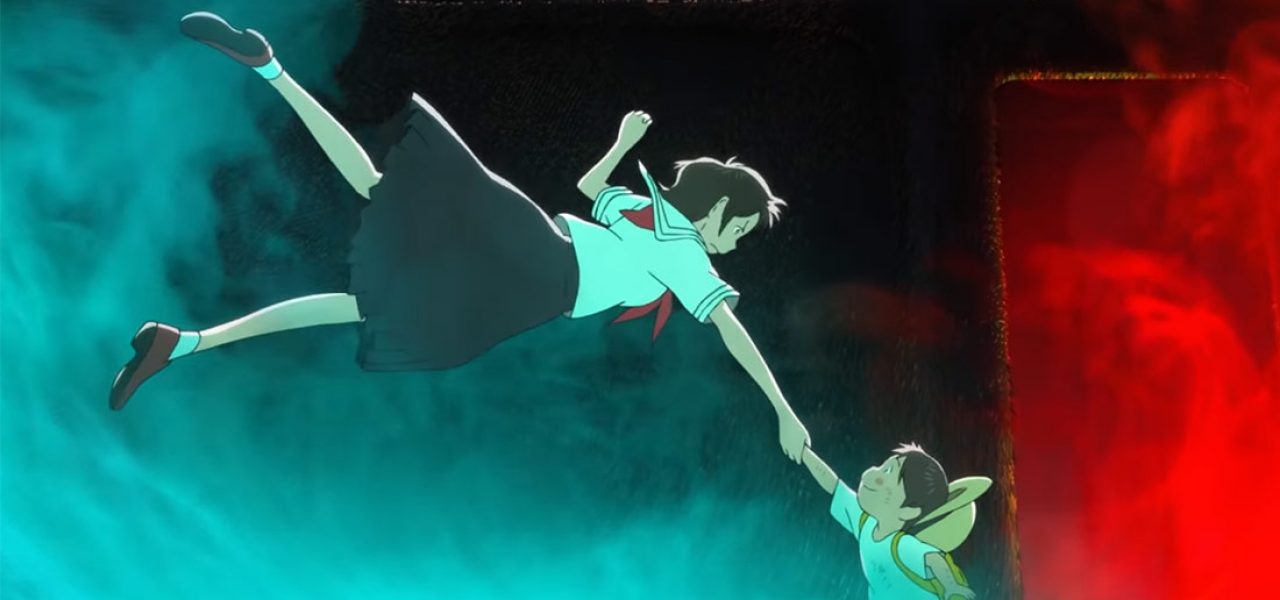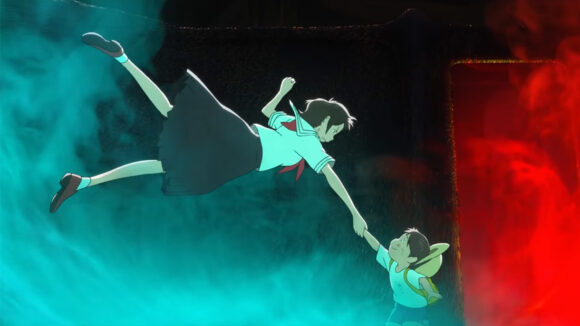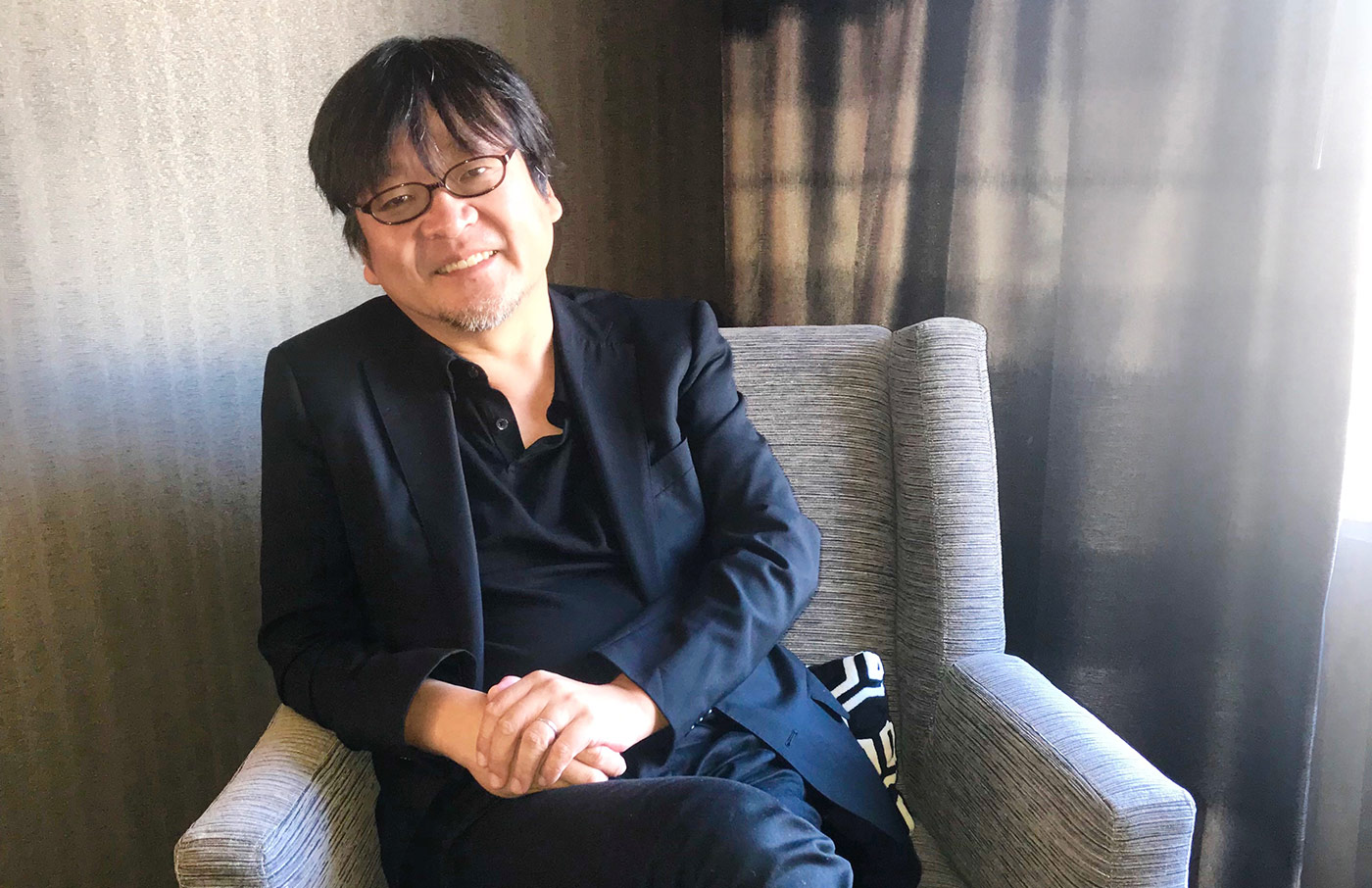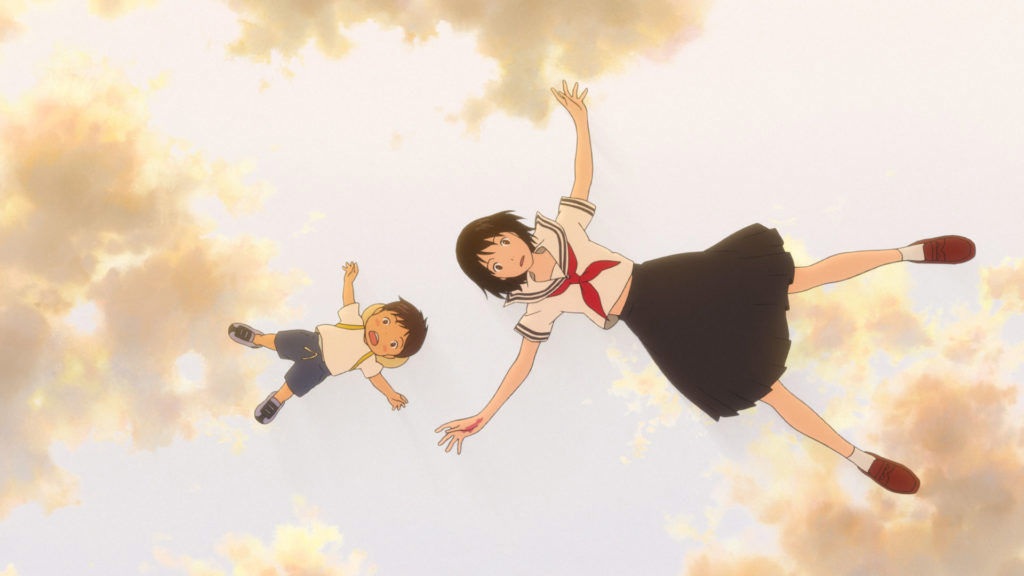

INTERVIEW: Mamoru Hosoda On The Profoundly Personal Making Of ‘Mirai’
Reaching a new affecting peak in his splendid career as a storyteller, animation auteur Mamoru Hosoda, 51, tapped into a well of personal inspiration for his newest feature Mirai, a lived-in portrait of early childhood, parenting, and family ties elevated by wondrous visuals and magical realms. The film, which had its world premiere at this year’s Cannes Film Festival in the Directors’ Fortnight sidebar, is a heart-warming standout within Hosoda’s already exceptional track record.
Produced by the director’s company, Studio Chizu, Mirai blends hand-painted backgrounds and hand-drawn characters with digitally fabricated components for an unassumingly sumptuous time-travel dramedy. This is Studio Chizu’s third movie following Hosoda’s Wolf Children and The Boy and the Beast, two other similarly themed gems.
Kun, the four-year-old would-be hero, is an adorably feisty boy whose emotions run rampant when his infant sister, Mirai (Japanese for “future”) comes home. Jealousy and the daunting realization that he is no longer the sole center of attention upends his young existence. Retreating to his modern home’s backyard, Kun ventures into fantastical episodes where he meets Mirai as a teenager, his dog in human form, and other relatives from the past who teach him valuable lessons. Like in all of Hosoda’s works, humor and heart are always in conversation.
In Hollywood last month for Animation Is Film Festival, where Mirai had its U.S. premiere, Hosoda had an extensive conversation with Cartoon Brew about mixing handcraft with cg, modeling the characters after his own children, and how being a seasoned animator enhances his directorial skills. The interview was conducted through a translator.

Cartoon Brew: The press has referred to Mirai as your most personal film. Why do you think that is? Is it directly influenced by your personal life?
Mamoru Hosoda: Actually, all of my films are very personal, and they’re based on my own experiences. For example, Summer Wars, I thought of it because I got married, and then with Wolf Children, my mother had died, so it was a movie to honor my mother, and then for The Boy and the Beast, I was trying to learn how to be a father and thinking about that. So for Mirai, when we had a baby girl, I wanted to showcase how my son changed with welcoming his little sister, and I wanted to depict a story about how a boy changes truthfully.
Tell me about your writing process. Do you write a screenplay in the traditional sense, or is it more of a storyboard that conveys your ideas?
Mamoru Hosoda: I actually write the script first, [and] at the point it’s almost complete, I show it to my producers and I get their opinions on how it looks, objectively. Once that’s done, then I go into storyboarding. I do all the storyboards on my own; I do that for consistency. So it’s script, revision, and then storyboards.
Do you draw at all as you’re writing?
Mamoru Hosoda: I try to separate the scriptwriter in me, versus the director in me. When I’m writing, even if I think of something, I try not to draw out anything, because the director in me would probably be like, “No that’s not right.” So I purposely separate the two.
In Mirai, you once again worked composer Masakatsu Takagi who’s worked with you on Summer Wars and The Boy and the Beast. What is it about his music that you find particularly fitting to accompany your work?
Mamoru Hosoda: Usually, when you ask a film composer to work with you, you sort of have an idea, and then you say, “Can you create music for this scene?” and then they compose for that scene. The good part about Mr. Takagi is that he is very original because he is not strictly a film composer. His music doesn’t sound like a film score. Sometimes it is hard just because of that, but I really like the original aspect of his music. For Mirai, I really wanted to express a child’s world through music, and Mr. Takagi, in a good way, is very childlike, he has this innocence, so I really thought he would be the perfect person to write the music for Mirai.
Something I really enjoyed about Mirai in the visual style is the backgrounds. Is this component something you dedicate a significant amount of time to?
Mamoru Hosoda: I know people think that in Japan, it’s all hand-drawn, and America tends to do cg animation, and yes, for Mirai it was paint-on-paper background, but I think this is going to be one of the last animated movies with paint-on-paper backgrounds — other than the new project that Miyazaki is working on. It’s really unfortunate, because in Japan there’s not going to be any more painters. If you go into a painters’ studio, they’re literally just painting backgrounds that look like pictures, and it’s really a good sight. But because this might be one of the last films to have painted backgrounds, I really wanted to express the whole gamut, and how good it looks when you have paint-on-paper backgrounds. I’m hoping you saw that in Mirai as well.
What do you think is different about hand-painted backgrounds from digital? Can you tell the difference easily?
Mamoru Hosoda: It’s completely different. When the background is done digitally, you can tell it’s digital, because there’s software that sort of makes it look like it was painted on paper, but you still don’t get that sense of, “Oh yeah, that’s actual paint on paper.” I’m really sad about it. This time, thank goodness to the budget and the people who were available to do it, I was able to incorporate it in, but from now on, it’s just all probably going to be digital.
How many artists painted the backgrounds?
Mamoru Hosoda: Twenty people, but these are probably the last people in Japan who do it, because everyone’s always going to say, “It can be done digitally.” There are no projects with the budgets to support their work. So it’s the same thing in America; there used to be hand-drawing animators, but now they’re all gone, because there’s no work. Japan was holding out.
How much cg animation did you use in Mirai and for what elements?
Mamoru Hosoda: We actually used a lot of cg, but we put in a lot of effort to make it not look like cg. Maybe about half of it is cg. Some parts like the train station at the end, or when they’re going off on the motorcycle were cg. This is a secret, but one character is completely cg, but I can’t say which character [Laughs]. All the other characters were hand-drawn, but from now on, I really think all of the characters are going to start to become cg.
That’s unfortunate that this might be your last film to really showcase a handcrafted aesthetic.
Mamoru Hosoda: Yeah, I’m really sad about it. Miyazaki, he’s like the last holdout, but he’s probably going to really retire after this next one. I’m going to still make films, so I’m really sad.
Will you try to include as much hand-drawn elements as possible in your future films?
Mamoru Hosoda: I was talking about this in earlier interviews, but it takes about three years for me to make a film, so I’m worried that by the time I’m able to hire these painters, they are probably going to be gone. I’ll try, but because it’s a movie, it’s not like just one or two hand painters are enough. We’re going to need 20 people, and I’m not going to be able to find 20 of them.
In terms of the character design, did you base any of the characters on people from real life, or where did the design come from for Kun and the other characters?
Mamoru Hosoda: For Kun and Mirai, their looks and how they act is completely based on my two children. I actually brought my children to the studio and had the animators sketch them, but not only sketch them, but hold them to see how heavy they are to get a sense of the weight, or touch how soft their cheeks are, or how soft their whole bodies are, or even touch their hair and feel how thin a child’s hair is, just so they could express these qualities in the animation.
How did your children feel about this?
Mamoru Hosoda: They actually hated it. In the beginning they didn’t like it at all, because it’s a weird atmosphere. They had to be in the middle of a room, and animators surrounded them. It’s a little intimidating, and we’d say, “Can you do this?” or “Can you do that?” and they’ were like, “No.” [Laughs]. Eventually they got used to it, and I figured out how to make them relax by preparing toys and stuff.
When you started your career you were an animator. Do you miss drawing now that you are a director?
Mamoru Hosoda: I don’t really miss it. Like I said earlier, I separate the scriptwriter and the director, and I also separate my animator side from my director side. But because I was an animator, I understand how animators feel. Right now, I enjoy the fact that I draw storyboards that are easier to understand for animators, or storyboards that would make animators go, “Okay, I want to animate this.”
Is it better for someone who understands the process of animating to become a director?
Mamoru Hosoda: Not exactly, because Isao Takahata didn’t draw at all, but he directed very well. Based on my experience, maybe I do feel a little bit like being an animator means I understand more, but it’s not a rule.
How is the job of an animated feature director different from one that works in live-action?
Mamoru Hosoda: Unlike a live action director, we don’t give direction verbally. A lot of that is written on paper, like, “The face angle should be this way,” or “The layout should be this way.” We write it or draw it, and that’s how we give directions to the animators. That’s why I think being an animator helps, because that means I can draw. Sometimes the animator would be so bad, I would just have to draw everything for him and say, “This is how you do it.” I can do that, because I’m a former animator. The part that takes the most time is really just the animating: animating the movements/actions. I think about 80% of directing is about that. I do have meetings between the departments, and then separate meetings with the composer, etc., but the big part is mostly just drawing and writing, and giving direction to the animators.
What was the most difficult sequence to animate in Mirai?
Mamoru Hosoda: It’s not really a sequence that was difficult to animate, but it was really the four-year-old Kun, making him realistically a four-year-old. In the past, I feel like children have been depicted as exaggerated, or they moved like adults in a smaller size, but that’s not realistic. Children, because they have a bigger head, have a different center of gravity, and they’re a little more awkward. Their actions, especially something like going up stairs, is not like how an adult would walk up; they struggle with this. I really worked hard on how to express realistically and accurately what a four-year-old would do. It was satisfying that we were able to do that, but it was really the biggest challenge of our movie.
There are also sequences in Mirai where the design of the animation is different, like the clock-man in the train station. Why did you decide to make that segment different from the rest of the film?
Mamoru Hosoda: The train sequence, with the lost and found guy in the clock, I was trying to remember when I got lost as a child, and how my imagination would run wild and everything would look scary. Even when you’re a child, humans are humans, but when you’re lost, the whole anxiousness makes even the humans you’re used to look scary, cold, and robotic. That’s why I used cut-out art to try to depict the scariness of how a child who’s lost would see other humans.
Were they physical cutouts or were they created digitally?
Mamoru Hosoda: The cutouts were actually physical art, and then we moved them digitally. The lost and found guy is such an important character. He asks Kun about his identity, “Who are you?” so I really struggled with his look. I really talked it through with the children’s literature artist who designed the cut-art: Tupera Tupera. They are a couple that creates children’s books and we hired them to create the cutout characters. I discussed with them how to make his expressions be worthy of asking Kun that question. I really struggled with that.

In terms of the themes in Mirai, and most of your films, would you say the link between all your feature works is the prevalent idea of the passage of time and the hardships of growing up?
Mamoru Hosoda: The main interest I have is how people change, and what brings upon that change. I guess that’s why I bring in family or children, because with children they grow, but they don’t just grow, they change. That’s why I used the time leap to show how they had changed. By the characters changing, I do believe that changes society and the world, and I want to depict that.
Is time travel something you would find useful in your life? It’s such a big part of your films.
Mamoru Hosoda: When I was working on The Girl Who Leapt Through Time, someone had asked me, “How come Makoto only time leaps in such a short time span? Everything that she does is only in a week or so, and if I had the ability to time leap, I would go all the way in the future or all the way in the past.” But I’m not really interested in that, because going all the way to past or the future is done in Doraemon a lot. I feel like, as humans, we sort of want to change the little regrets we have in everyday life. We want to fix those small mistakes. I feel like humans want to improve their own lives that way. It’s a little selfish, in a cute way. I think if I had the ability to time leap, I would probably just fix things only in a two week span, because I think I could improve my life that way.
What did your children think about the film, and did they get the message you were trying to get across?
Mamoru Hosoda: They loved it. They knew that they were the models for this movie, so I was curious how their reaction was going to be, but they really loved it like any other kids would. To them, because they’re only 6 and 3 now, the way they took the movie might be different from how they’ll see it later on in their lives. Maybe when they’re adolescents, they might watch the movie and go, “Oh my gosh it’s so embarrassing, I can’t watch it!” [Laughs]. But then it’ll probably change again when they see it as adults, and maybe when they have children they’ll probably have a different view of what the movie is trying to say. Maybe that’s when they’ll truly understand what the movie is trying to say.
With that in mind, is there anyone in your family you would you would like to meet as children?
Mamoru Hosoda: Of course, it would be my parents, my mother and my father. We can look at old pictures, and you can sort of see how they were, but you can’t really tell how their personalities were, especially now, because they’ve passed away, you can’t really see them anymore. I would think anyone would want to see their parents when they were children. Isn’t that the same for you?
Maybe. I’d be a little scared to see how much we’re alike.
Mamoru Hosoda: Yeah, I wasn’t really that interested in what my parents were like when they were still alive, but now that they’re gone, I do wonder a lot about how they were.
Do live-action films inspire you at all? There’s a Japanese filmmaker, Hirokazu Kore-eda, who also makes profound movies about families and father-son relationships. I thought about his work watching Mirai.
Mamoru Hosoda: Actually, I don’t hang out with a lot of directors, in animation or live-action, but Kore-eda is actually someone I’m pretty good friends with. When Mirai premiered at Cannes, Mr. Kore-eda came to watch the movie, and he said, “If I was going to make an animated movie, it would probably look like Mirai.” I feel like we’re comrades. It’s not like Kore-eda’s films inspire me, but I feel like we both have the same themes and motifs. We try and depict Japan’s societal problems and the family, and how they’re connected. When I was younger, when I was in college, I used to be inspired by a lot of international directors like Victor Erice, Leos Carax, Edward Yang, and a lot more.
Do you have a favorite film by Kore-eda?
Mamoru Hosoda: I like all of them, but one I saw recently was Shoplifters. There’s another one called Still Walking, which also like a lot. When I made The Boy and the Beast, people had said, “It’s very similar to Kore-eda’s Like Father, Like Son, but I actually hadn’t watched it at that point. I finished the movie, and then I watched Like Father, Like Son. When I was making The Boy and the Beast, because it’s about a father, I was like, “No one else is going to make a story about a father,” but Kore-eda had already made his film, and I was like, “Ah man!” [Laughs] But I did see it after, and that’s why I feel a connection to Kore-eda, because I guess we have the same ideas and taste.
Early in your career you worked on very beloved anime shows like Sailor Moon, Dragon Ball, and Digimon. Do you think of them fondly? What are some memories you have of working on those shows?
Mamoru Hosoda: I do think of them in a nostalgic way, but these shows are still popular, and they’re rebooting them. I don’t really plan to watch the new ones. I worked on the old ones, and I feel nostalgic for those, especially Digimon, because it was my directorial debut. That show does hold a special place in my heart. There are so many young people who are like, “I saw Digimon and I loved it.” I get that a lot, especially in the USA, so I’m really happy about that, because they watched it when they were 6 or 8, and they’re like 20-something now, and I’m like, “You’ve really grown.” [Laughs].
How has the industry changed in terms of making anime or animated films, from when you were working on those shows to today?
Mamoru Hosoda: I feel like everything is digitized. What’s interesting about the difference between the USA and Japan is that in the USA when everything got digitalized, everything really switched to looking digital, and in Japan, even with the technology advancement, Japan really wanted to keep the hand-drawn style. But I really think this is a turning point, in which Japan might start thinking, “Let’s start making it look digital as well.” It’s really similar to the turning point when the photograph was invented. When the photograph was invented, all the painters probably thought, “Well what is the meaning of my existence? Are we going to keep doing what we did, or are we going to change our style?” And that’s when the impressionists came, and they changed their style to differentiate themselves from photographs. That might happen too, but we don’t know. We’ll see.
Animation is Film Festival played a retrospective of your work. When you go to an event like this and you have to introduce each one and do Q&As, what kind of memories do you get from all of these films when you have to talk about them now?
Mamoru Hosoda: I’m actually one of those directors that doesn’t watch their films once their done. At film festivals, when I have to say something to introduce them, it makes me really happy, because I talk to the audience and say, “Let’s be friends, because it’s really my world and myself.” When I introduced Summer Wars, I asked the audience, “How many of you are watching this for the first time?” and for maybe half the audience it was their first time, and that made me really happy, because I was like, I hope you enjoy it. It was a really happy moment.
GKIDS will open Mirai in New York and Los Angeles on November 30, followed by a platform release across the U.S. For tickets, go here. It will also screen nationwide in select theaters on November 29, December 5, and December 8 through Fathom Events.

.png)